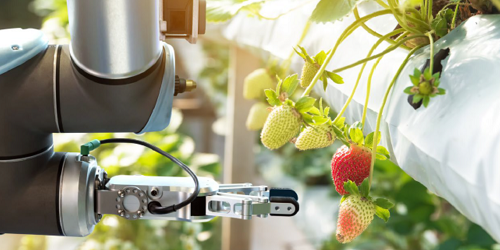Article: November 2020
Growing with technology: Australia’s agricultural future will need a comprehensive approach
There’s nothing like an empty supermarket shelf to remind us how utterly dependent we are on agriculture.
In the 1980s we were told agriculture was a sunset industry destined to decline in importance as the service and technology sectors grew.
Fast forward to today and not only is agriculture still among Australia’s most important export industries, food processing is also our largest manufacturing employer and, at risk of sounding facetious, we still eat. As COVID-induced panic buying stripped supermarket shelves bare earlier this year, Australia’s farmers, processors, logistics firms and retailers adapted and rose to the challenge.
The reality is that agriculture always has been at the forefront of technological innovation. No-one should be surprised that advanced sensing, automation, the internet of things, data analytics, artificial intelligence and other emerging technologies are already finding their way onto Australian farms. Sooner rather than later they will be commonplace.
What do these technologies really mean for agriculture though? Or for rural communities? Knowing a new tool is available doesn’t tell us what it might be used for or who gets to decide.
A report released on the future of agricultural technologies by the Australian Council of Learned Academies (ACOLA) examines the implications of nine technological developments in the sector, from nanotechnology to machine learning. The report, titled The Future of Agricultural Technologies, demonstrates the importance of keeping up with technological advancements in the coming decade – and the need to do so holistically.
Twenty-first century technologies offer tantalising possibilities to boost productivity, commercialise new products, distinguish Australian produce, verify its provenance and quality on the international stage, manage climate and biosecurity risks, solve environmental problems, improve animal welfare, and lift the profitability of agriculture.
There is potential to make a real difference to people’s lives by lifting farm incomes and rural employment opportunities.
There are inevitably risks too. Buyer resistance to products that are perceived as ‘unnatural’ is a persistent issue for development in the sector. Cost is also critical, because when farmers balance decisions to invest in technology against rates of return on capital, it doesn’t always make sense to introduce new devices. Inadequate connectivity, lack of local technical support and limited data processing capacity can further increase business risk for potential technology adopters.
Unless barriers to innovation are identified and addressed, there is an additional risk that change in Australian agriculture will not be quick enough, or substantial enough, to deal with climate-induced shocks and intensifying global competition.
It makes complete sense that the report released by ACOLA identifies investment in research and education as one of the key strategies needed for positive technological change. The report proposes that this investment should be spread across three critical enabling infrastructures – physical, regulatory and institutional:
- Physical infrastructure
Many emerging technologies require data management infrastructure to support data acquisition, storage and computing capacity across vast landscapes. Investment in physical infrastructure should include robust regional data centres and improved connectivity to provide rural communities the foundation for technology uptake. Boosting regional capacity will help create local jobs and raise access to the tools for development. - Regulatory infrastructure
Regulation of technologies aims to mitigate risks and potential harms, but can also create barriers to innovation. Investment in regulatory infrastructure should focus on resolving regulatory and policy issues to align technologies with community needs, and ensure the integrity and secure use of agricultural data. New devices often bring data-gathering capabilities, governed by a complex web of (often international) device manufacturers and service providers; it is important to find a balance between expanding data network capabilities and protecting Australian industry. - Institutional infrastructure
No single emerging technology will solve the challenges facing Australian agriculture, and the development process will need continual collaboration and revision. Investment in institutional infrastructure will provide a platform for cross-sectoral and cross-disciplinary collaboration in research, development and innovation. An emphasis on collaboration will help prioritise engagement with stakeholders across the supply chain, enabling response to dynamic circumstances and needs.
Taken together, investment in the right enabling infrastructure will support virtuous cycles of locally relevant research and innovation, education, industry application and technical services businesses throughout Australia’s regions. This extends to cultivating partnerships with Indigenous communities and natural resource managers, to link Indigenous aspirations and the Indigenous estate with opportunities for improved agricultural management.
This enabling effort can further encourage community uptake when technology is well-matched. The report shows that adoption is much higher when technology is designed with user needs in mind, which can present opportunities for greater inclusivity. Women for example are often the primary adopters of digital technologies, and report it as an empowering experience.
Agriculture is anything but a sunset industry. Now more than ever though, there is an amplified need for the agricultural sector to engage across the supply chain and with government, and to communicate new developments to the broader community, in order to benefit from emerging technology.
 Distinguished Professor Stewart Lockie FASSA is Chair of the Australian Council of Learned Academies (ACOLA) Expert Working Group for the Future of Agricultural Technologies Report (September 2019 – December 2019), and Distinguished Professor of Sociology and Director of the Cairns Institute at James Cook University.
Distinguished Professor Stewart Lockie FASSA is Chair of the Australian Council of Learned Academies (ACOLA) Expert Working Group for the Future of Agricultural Technologies Report (September 2019 – December 2019), and Distinguished Professor of Sociology and Director of the Cairns Institute at James Cook University.


